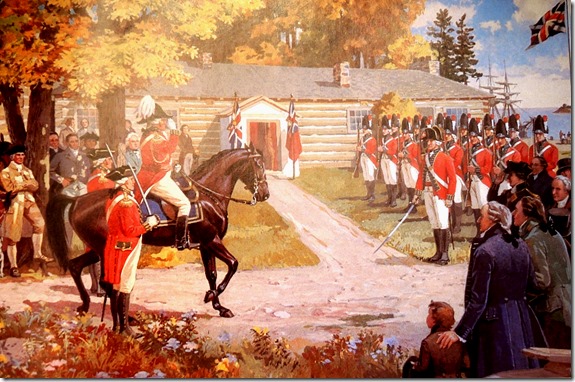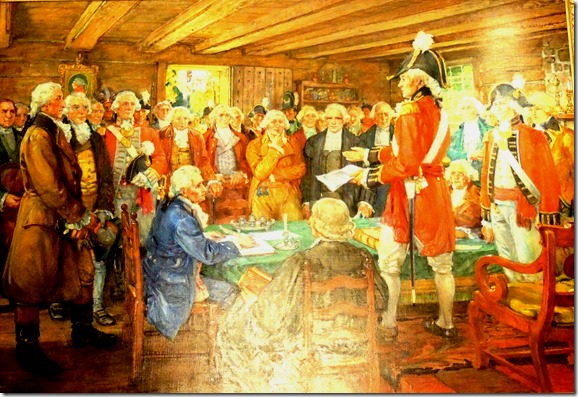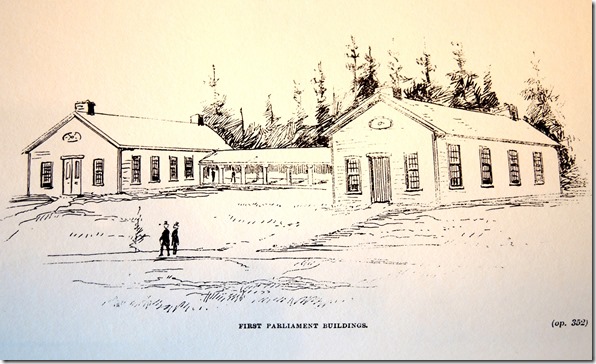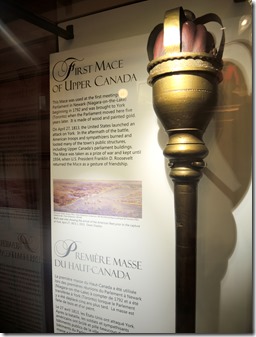The first legislative assembly of Upper Canada (Ontario) was held in Newark (Niagara-on-the-Lake) on September 17, 1792. The colourful painting by Rex Wood depicts Lieutenant Governor John Graves Simcoe arriving to officially open the session (collection of the Toronto Reference Library).
The painting shows the meeting of the first legislative assembly in Newark (the painting is part of the collection at Queen’s Park). It was reported that the 16 elected representatives met in a humble structure that resembled a shed. It was likely Navy Hall, which though not an impressive building, was hardly a shed. Tradition states that before the session ended on October 15th, some of the meetings were held outdoors under the shade of an enormous oak tree. Today, there is a plaque in Niagara-on-the-Lake that denotes the place where the “Parliamentary Oak” once stood. The “mace,” the symbol of governmental authority, was carried into the meetings by John McDonell. It was carved in fir or pine and the wood was gilded, with a crown on its tip.
Lieutenant Governor Simcoe relocated the seat of government from Newark to Toronto in July 1793 and in August of that year, renamed the town York. In February of 1796, Simcoe ordered the construction of Parliament Buildings to house the legislature on the east side of the town, south of Front Street, between today’s Parliament and Berkley Streets. The two structures were one-and half-storeys in height, with a passageway connecting them. They were officially opened in June 1797, after Simcoe had departed the colony.
This sketch from the Toronto Archives (F1257, id.2076(1)) shows the first parliament buildings. It is not a truly accurate depiction of the structures, as they were constructed of bricks, not wood. David Thomson, the builder of the structures, recorded that he purchased 55,000 bricks at a cost of 17/6 per 1000. In a letter that Governor Simcoe sent to the Duke of Portland on February 27, 1796, the buildings were described as consisting of two separate buildings, aligned north-south, an hundred feet apart. They were to contain offices and space for the legislature and courts of justice. Simcoe viewed them as temporary as he still preferred London (Ontario) as the site for the capitol of the province. However, a letter from Whitehall (London) in March of that year, overruled Simcoe and declared York (Toronto) the seat of government.
The wings of the legislative buildings were 40’ by 24’, with a colonnade built between them. A covered walkway was to suffice until the colonnade was constructed, but it did not materialize until 1805. Porticos across the west facades were supported by 8’ wooden posts. The buildings cost the government 10,000 pounds, an astronomical sum in those years. Henry Scadding in his book “Toronto of Old,” published in 1873, described the buildings as “humble but commodious structures of wood.” He was incorrect about the building material, and perhaps explains the sketches that appeared in later years.
This sketch is from John Ross Robertson “Landmarks of Toronto,” published in 1894 (page 353). It is more accurate as it depicts buildings of brick.
The first Parliament Buildings were set ablaze during the War of 1812, when the American forces invaded in April 1813. The library and the government records within the structures were also destroyed. The Americans carried away the parliamentary mace as a trophy of war. When the war ended in 1815, sessions of the legislature were held in the York Hotel, also known as Jordon’s Hotel, on King Street East, while new building were constructed on the same site. The second Parliamentary Buildings opened in 1820 and were also built of brick. They too consisted of two buildings, with a centre block connecting them. However, they were destroyed by fire in 1824, caused by an over-heated stove.
Sketch of the parliament buildings constructed in 1820, after the original buildings were destroyed by the Americans in 1813. The colonnade connecting the two buildings was replaced by a two-storey centre block. Sketch is from John Ross Robertson’s, “Toronto Landmarks,” Volume 1, page 352.
Sketch of York (Jordan’s) Hotel on King Street East where the legislative assembly met during the reconstruction of the buildings torched by the American. Sketch is from John Ross Robertson’s “Landmarks of Toronto,” Volume 1, page 14.
The parliamentary mace employed at Newark, brought to York, and carried away by the invading American forces in 1813. It was returned to Toronto by President Roosevelt in 1934, on the occasion of the city’s centennial. Photo taken in May 2015, when it was on display in the Ontario Legislative Buildings at Queen’s Park.
Sources: ontarioplaques.com – educationalportal.on.ca — “Toronto Landmarks,” John Ross Robertson, published 1894 — “Toronto of Old,” Henry Scadding, published 1873 — “No Mean City,” Eric Arthur, published 1964.
To view the Home Page for this blog: https://tayloronhistory.com/
To view previous blogs about movie houses of Toronto—historic and modern
Recent publication entitled “Toronto’s Theatres and the Golden Age of the Silver Screen,” by the author of this blog. The publication explores 50 of Toronto’s old theatres and contains over 80 archival photographs of the facades, marquees and interiors of the theatres. It relates anecdotes and stories of the author and others who experienced these grand old movie houses.
To place an order for this book:
Book also available in Chapter/Indigo, the Bell Lightbox Book Store and by phoning University of Toronto Press, Distribution: 416-667-7791
Theatres Included in the Book:
Chapter One – The Early Years—Nickelodeons and the First Theatres in Toronto
Theatorium (Red Mill) Theatre—Toronto’s First Movie Experience and First Permanent Movie Theatre, Auditorium (Avenue, PIckford), Colonial Theatre (the Bay), the Photodrome, Revue Theatre, Picture Palace (Royal George), Big Nickel (National, Rio), Madison Theatre (Midtown, Capri, Eden, Bloor Cinema, Bloor Street Hot Docs), Theatre Without a Name (Pastime, Prince Edward, Fox)
Chapter Two – The Great Movie Palaces – The End of the Nickelodeons
Loew’s Yonge Street (Elgin/Winter Garden), Shea’s Hippodrome, The Allen (Tivoli), Pantages (Imperial, Imperial Six, Ed Mirvish), Loew’s Uptown
Chapter Three – Smaller Theatres in the pre-1920s and 1920s
Oakwood, Broadway, Carlton on Parliament Street, Victory on Yonge Street (Embassy, Astor, Showcase, Federal, New Yorker, Panasonic), Allan’s Danforth (Century, Titania, Music Hall), Parkdale, Alhambra (Baronet, Eve), St. Clair, Standard (Strand, Victory, Golden Harvest), Palace, Bedford (Park), Hudson (Mount Pleasant), Belsize (Crest, Regent), Runnymede
Chapter Four – Theatres During the 1930s, the Great Depression
Grant ,Hollywood, Oriole (Cinema, International Cinema), Eglinton, Casino, Radio City, Paramount, Scarboro, Paradise (Eve’s Paradise), State (Bloordale), Colony, Bellevue (Lux, Elektra, Lido), Kingsway, Pylon (Royal, Golden Princess), Metro
Chapter Five – Theatres in the 1940s – The Second World War and the Post-War Years
University, Odeon Fairlawn, Vaughan, Odeon Danforth, Glendale, Odeon Hyland, Nortown, Willow, Downtown, Odeon Carlton, Donlands, Biltmore, Odeon Humber, Town Cinema
Chapter Six – The 1950s Theatres
Savoy (Coronet), Westwood
Chapter Seven – Cineplex and Multi-screen Complexes
Cineplex Eaton Centre, Cineplex Odeon Varsity, Scotiabank Cineplex, Dundas Square Cineplex, The Bell Lightbox (TIFF)


![f1231_it2076[1] f1231_it2076[1]](https://tayloronhistory.com/wp-content/uploads/2015/08/f1231_it20761_thumb.jpg)

![Tor. Landmarks Vol 1, page 352, second_parliament_building[1] Tor. Landmarks Vol 1, page 352, second_parliament_building[1]](https://tayloronhistory.com/wp-content/uploads/2015/08/tor-landmarks-vol-1-page-352-second_parliament_building1_thumb.jpg)


![cid_E474E4F9-11FC-42C9-AAAD-1B66D852[1] cid_E474E4F9-11FC-42C9-AAAD-1B66D852[1]](https://tayloronhistory.com/wp-content/uploads/2015/08/cid_e474e4f9-11fc-42c9-aaad-1b66d8521_thumb1.jpg)

